Why the CEO has to be the chief blogger
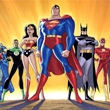
Successful social media strategy starts at the top of every business
It's misguided to think social media can simply be delegated to the youngest in the business, or outsourced to a digital agency. Social media is simply another relationship management channel. So it makes sense the strategy of what will be discussed in social media and what won't lies with the CEO. Social media is the one place the CEO's message can get through direct to the individual, without being filtered.
So if you're the CEO, consider this medium as your direct way to have a personal conversation where you can champion what you believe in. Before you begin, reconsider what you want your business to be known for. Ask yourself what is at the heart of why people should buy from your business, rather than your competitors?
Recent research by PR firm Weber Shandwick shows social media has positive impacts on business. (Click to enlarge.)
This simple checklist will help frame the social media agenda for your business
- What is the purpose of the business, what will success look like?
- What is the business strategy?
- What does the business believe in?
- How does it add value?
- What are its beliefs and ethics, its reason for being, its mojo?
- What is the business story? The way you express your differentiation, the reason for customers to choose you.
- Who does the business want to help? Who do you want to leave for your competitors to lose time or money trying to please?
- Who does the business want to influence? The gatekeepers to your prospects, or perhaps the well connected people who might bad mouth you through ignorance?
- Who does the business want to work with? Do you have affinity partners or associations you can share your blogs with?
- What kind of people does the business want to attract? It now matters what you look like in the blogoshere because it's the first place most potential employees will check you out.
Reputation risk has been elevated by social media
As equally important as having a social media presence is what you say. Being active across social media brings new risks. What is published online stays online, potentially forever. No wonder reputation risk is now the number one concern of CEOs globally according to the latest report from Deloitte.
Perhaps if more CEOs took control they would minimise the risk of staff who know less being the main originators of social media conversations. The CEO is best placed to set the agenda, staff can then follow through.
According to research by Weber Shandwick, more than six in 10 CEOs are already posting content on company websites. Yet only 18 per cent of the CEOs surveyed participated on social networks. The chart above gives an overview of the survey findings. Interstingly, 80% of staff want to see their CEOs on social media, largely because it's where they want to keep up to date.
I feel most CEOs I talk to are missing this powerful opportunity to spread the truth about their business vision. Social media is where these truths are shared and discussed, it's one place the leader can champion their cause with passion.
Read MoreWhat makes mid-sized businesses more profitable than big?
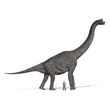
So what is a mid-sized business?
GE Capital has been defining the mid market in Australia as businesses that have annual revenues of between A$10 million and A$250 million. Average firm turnover is about A$41 million. Despite comprising just 1.4% of companies by number, mid-market firms provide one in four full-time jobs and contribute A$425 billion annually to the economy.
The federal Department of Innovation, Industry, Science and Research, which has a broader definition of medium-sized businesses as those with between 20 and 199 employees, puts the economic contribution of the mid-market considerably higher.
The mid-market campaign we successfully managed over four years for IBM targeted businesses from 99 and right up to 999, the large corporate and government sectors that IBM traditionally owned really kick in around 1,000 staff.
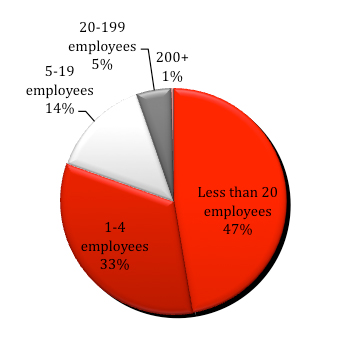
Australian Business
Most mangers still hold the belief big means better. We hold a belief businesses can only succeed today by being nimble. The reason for this is the profound change the Internet has brought to our lives. The world even quite recently was quite slow to change, and most businesses were relatively simple. Today we all compete in a world of rapid paced change and increasing complexity. So the old big business model of slowly and effectively finding savings from gradual improvements to products and services and small efficiency gains in management and procurement are no longer enough to stay competitive. Let alone stay in business.
The evidence for the decline in profitability of big business is seen in this chart. It shows one third of market leaders in their category in 1950 were also the most profitable businesses in their category, whereas today being big almost guarantees you’ll be struggling to make a buck.
Market leaders that are also category profit leaders:
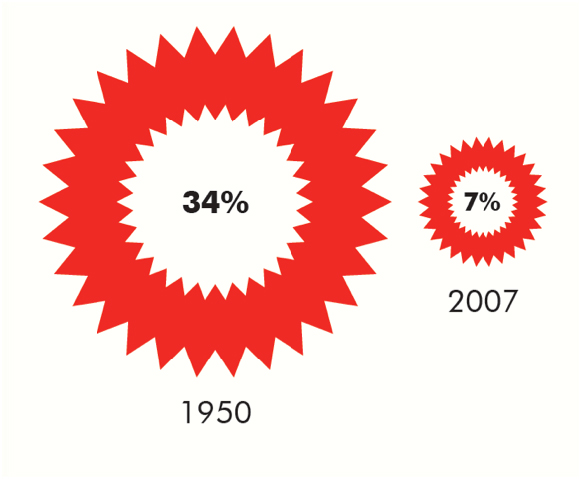
What makes big business vulnerable to challenger brands
George Shinkle is a Lecturer in the School of Strategy and Entrepreneurship at the Australian School of Business. He has been studying why big business is failing.
“Organisations grow large by becoming more efficient, so when you’re really focusing on efficiency you typically become less and less flexible. The rules and processes and procedures become more and more about keeping you efficient, constraining your ability to be flexible,” he says.
“If you talk to the CEO of a very large firm, they don’t feel as if they’ve got direct control of what the organisation’s really doing. They give guidance and they set policy but the organisation has some variance on how well they follow those things,” says Shinkle.
The learning you can take advantage of is that managers in large companies try to hide from change. Which is why, if you’re running a mid-market business, you will create your own advantage by actively seeking out things to change to differentiate from the competition.
Not too big, not too small, mid-sized business is just right
Big business is still obsessed with conformity, groupthink and doing things the way they have always been done around here. Small businesses may be the birthplace of great ideas, but they usually don’t have the scale or resources to commercialise those insights.
The mid-sized business is perfectly placed in the middle, where the distance between innovative thinkers and management that can actually make decisions is short. Unlike small business, resources aren’t so slim ideas can’t be trialled without damaging the existing business of running the business.
At a CEO Institute meeting Susan Lenehan told me the biggest frustration of the CEOs of Australian arms of global businesses she mentors is their total lack of autonomy. They are prescribed what to do by head office irrespective of local circumstances. In her words, it’s the pinnacle of the “bully culture” of big business management.
Challenger brands will prosper by taking risks
This is the great opportunity mid-sized Australian businesses are exploiting, they can leverage their ability to try changes, while the big guys are stuck in the inertia of business as usual, with its five year plans, annual targets and quarterly reporting. By challenging traditional big brands, Australians can be globally competitive in a world that is changing daily.
The real successes come from maximising returns by minimising the risks of change – we developed the challenger brand formula for growth for this very reason.
Why you need brand awareness before sales
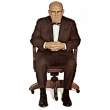
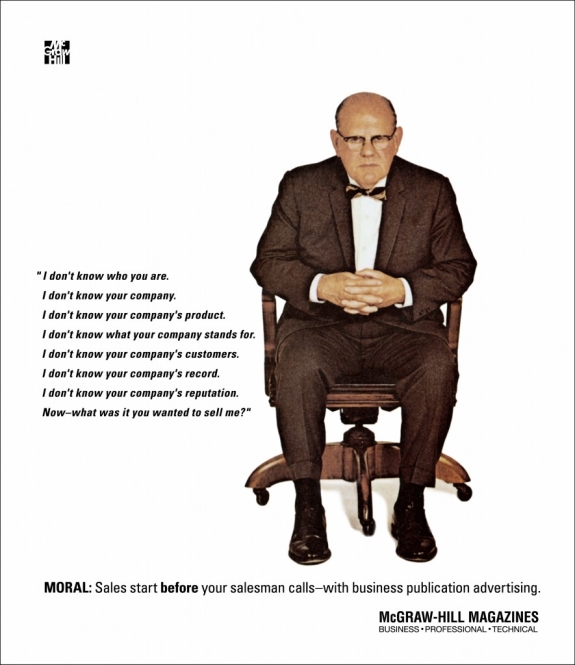
This famous ad for advertising with McGraw Hill appeared in 1958
Business owners sometimes need reminding of the timeless challenge, why would a prospect buy from you rather than one of your competitors?
For 50 years the simple answer was to spend more on advertising than the rest of your category. As marketers now realise, simple strategies in this Internet enabled world now require more complex solutions.
Challenger brands can succeed today without big ad budgets
The good news is smaller businesses can now be successful challenger brands with smaller budgets than the big brands. The staring point is to differentiate. with a singleminded story that prospects will value. you can then apply a test and learn approach to marketing across multiple mediums. Smarter strategies applied with insight will now succeed while big spending inflexible brands continue to struggle.
Read More73% of marketers say more has changed in 2 years than the past 50
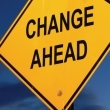
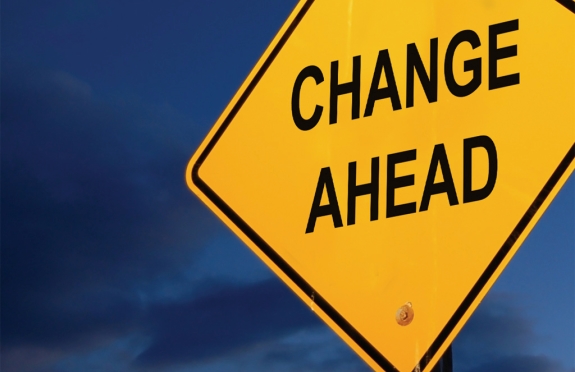
Who are you going to call to advise your business on how to grasp the rapidly expanding number of marketing communications options? Usually you’d call in an expert. However, the pace of change right across the business world and the complexity of competing solutions is so great how can any individual be an expert? And big businesses may have lots of individuals, but we all know they rarely work as a team let alone communicate well with clients.
Marketing professionals are confused
A survey* by Adobe of 1000 marketers in the US shows the crisis in confidence of the marketing services.
“Marketers are facing a dilemma: they aren’t sure what’s working, they’re feeling under-equipped to meet the challenges of digital, and they’re having a tough time keeping up with the pace of change in the industry. What’s worse, no one hands you a playbook on how to make it all work,” says Ann Lewnes, Chief Marketing Officer, Adobe.
Digital marketing is full of novices
Adobe’s survey found less than half (48%) of marketers who consider themselves primarily digital specialists feel highly proficient in digital marketing. Most digital marketers haven’t had any formal training in digital marketing. No surprise really, it’s so new and evolving very few places can teach it.
The problem for business owners is how to leverage what’s new when so few people, if indeed any, know what will work. The people whose job it is to know, professional marketers, revealed in the survey the same old issues are today’s top challenges. 82% cited reaching their customers as the biggest challenge, then the uncertainty of knowing if their campaigns are working (79%), and measuring campaign effectiveness (77%) and marketing ROI (75%).
The answer for marketing your business?
Today every part of the business has to take risks
Whether it’s your accounting systems, distribution, IT or marketing, everything now is facing change. It’s hard enough to know the right question to ask anymore, let alone have the right answer. The safest option today is counterintuitive – it’s to realise you can’t predict winners anymore.
So the safe approach with marketing is no longer to set and forget. Rather than taking a long time and spending a lot of money attempting to develop the one perfect solution, try a lot ideas and mediums. And try them quickly and often.
Test. Learn. Adjust. Test again.
Learn to feel comfortable with failures. Set out to make the risks small so the stakes aren’t too high. Then go for it with a test and learn approach to marketing. The more often you fail the quicker you’ll find yourself challenging the competition and being successful.
* Source: Adobe and Edelman Berland, online survey among a total of 1000 US marketers. Marketing Staff (n=499), Marketing Decision Makers (n=436), Digital Marketers (n=263), and Marketing Generalists (n=754). September 2013
Read MoreAre fashion retailers training customers to buy on sale?
I've written in the past how Zara led the world by applying just-in-time manufacturing and data analytics to bring us fashion forward product design. This has given them an advantage over traditional retailers by circumventing the traditional seasonal approach to fashion.
Instead of waiting for the leading designers to reveal on the Paris catwalks what we'll be wearing next year, Zara's innovation was to take the Dell Computer model. Zara replenishes stock in their stores every week, see what sells, then make more of what is popular. Rather than sitting on large quantities of stock hoping people will like what style you've backed, Zara take a test and learn approach. They never back one colour or style for a full season, Zara simply adjusts what they manufacture on the fly to what the consumer wants this week.
Fashion challenger brands risk destroying the advantage they have created
Retailers are losing the power to maintain margins by encouraging a buy on sale mentality. According to Robin Givhan, the only clothes critic to win a Pulitzer Prize, with the constant turnover and turnout of items due to the ever-quickening fashion cycle, there’s no need to buy anything at full price anymore.
While bloggers and fashion critics have used social media to drive awareness and demand of the weekly fashion cycle, retailers she says are to blame for the loss of their pricing power.
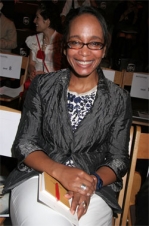
"Retailers talk a lot about how the availability of show images pique the interest of consumers before the clothes are available. But I blame retailers for creating a system in which they want spring clothes in November and more shipments every five second[s] and then putting things on sale when they've only been on the racks for one second," said Givhan.
Consumers usually don't know how to establish the value of something, it's actually within the power of the seller to frame the price that they will believe is fair.
Innovate for pricing advantage
If you have innovated your way to a price advantage, don't throw away your smartly won margin. Instead, decide how you can frame the price as fair value, for instance in terms of more for the same, or faster for the same, or better for the same. Offering something for less is an approach fashion retailers are finding comes at the cost of not just profit, but long term survival.
Don't drive your category to the bottom the way Persian Rug stores have, where in every corner of the world the SALE sign on the window now means OPEN. Here's one I snapped in Hong Kong...
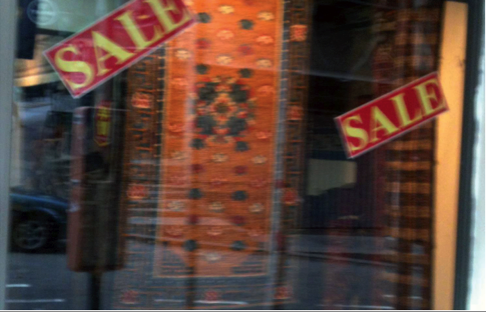
Do you have a clear point of difference to drive growth?


Staying in business has never been harder. 10,632 companies collapsed in the 12 months to March 1 2013 - ASIC also reports the number of firms being placed in administration is more than 12 per cent higher than during the GFC. Over the last few months an average of 44 small businesses were closing every day according to ABS data.
A change of government won’t change the fact the pace of change is still accelerating, the choices for customers continue growing and the decisions we all face in life are more complex than ever.
Where will your business growth come from?
These are your options:
- From existing clients
- By getting new clients
- Expanding to new locations, (interstate, overseas)
- Developing new services
- Making acquisitions
90% of businesses focus on number 1, selling more to current customers or charging them more. Yet the upside is limited.
Of the small number that go down the acquisition path most are disappointed. An AGSM survey of mergers and acquisitions showed after 3 years just 10% exceeded expectations of synergy and only 10% - 15% met expectations. The rest had failed or were in a death spiral.
Expansion and new product or service development often require a large commitment of resources and takes attention away from the existing business.
Which leaves new business as the key driver of growth. Marketing is the one proven method that can drive scalable new business growth. A successful new business program begins by confirming you have a differentiated offer relevant to today’s customer. Every prospective customer has more than one choice. What does your business have that makes it so special they have to choose you?
Customer alignment, simplification and innovation
Here’s a simple technique that GE Capital employs to keep their business differentiated in this time of rapid change. 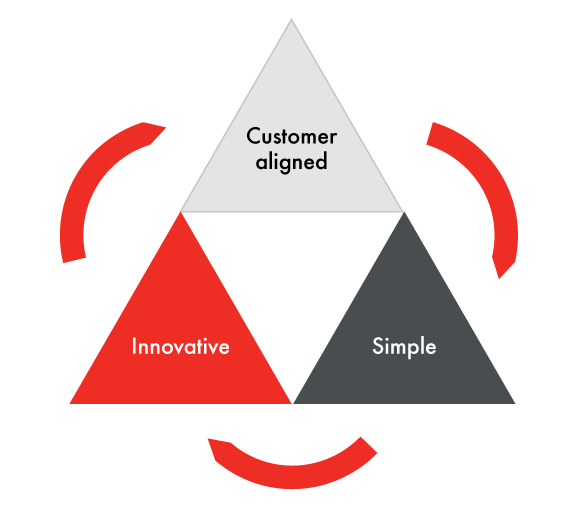
Customer aligned
- Employees know which customer segments we serve and what their top 3 needs are
- Our organisation rallies around these needs (customer facing & support departments)
- We continuously track customer metrics at a transaction, product and business level
- We respond to customer feedback fast
Simple
- We do less, better
- Our customer processes are intuitive
- Our internal processes are as easy as our customer processes
- We routinely identify and eliminate the bottom 30% flow value processes, reporting and meetings
Innovative
- We encourage, empower and reward staff who challenge the status quo
- We launch new ideas fast (< 45 days average)
- We have a full pipeline of ideas linked to incremental volume
- We invest a significant amount annually on innovation
Differentiation for new business growth
Don’t hold your breath waiting for the government to simplify regulation, align their policies with your needs or innovate the country’s way to prosperity. Look at your current structure, reconsider what the business currently offers and determine a positioning that will differentiate you from your competition. Today.
This is just one of the tools UNO uses to ensure when our challenger brand clients invest in marketing, the returns will be worth the effort.
Read More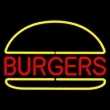
There are few categories more sophisticated at marketing than fast food. For 50 years McDonalds has been fine-tuning their brand marketing driven machine in Australia. Other brands may talk share of voice or share of wallet, McDonalds is famous for wanting the largest share of stomach in the country.
The business is a great example of how to upsell, cross sell and find new reasons for customers to visit. From breakfast muffins through burgers and happy meals to soft serves and late night treats, washed down by McCafe coffees in between. From Pasta Zu to chicken nuggets to who knows what else a machine can transform animal castoffs into.
Want fries with that?
All of these tactics are an excuse to get more people to buy fries more often, it's where the big profits are made. Makes you wonder how anyone can compete? If you don't work for an omnipotent global business there is evidence of hope. Roy Morgan reasearch released in August 2013 shows just how well new competitors can do by choosing to take a challenger brand positioning.
A case study in how positioning can outsmart the big brands
Hungry Jacks came much later, and has never had the footprint or the ad budget to compete head on. What has worked long term for Jack Cowin's fast food challenger up against a global heavyweight, is a differentiated positioning that gives it a clearly defined space to compete in. "The burgers are better at Hungry Jacks."
From day one they lived up to that positioning statement, better burgers; either with biigger burger patties, actual lettuce instead of a miserable pickled cucumber, to the first Angus beef burger, then bacon and now organic beef. Single mindedly niche focused, and better for it in the minds of customers, who consistently rank Hungry Jacks above Maccas.
Long-term customer satisfaction in fast food comes from smart positioning. Chart: Roy Morgan, August 2013
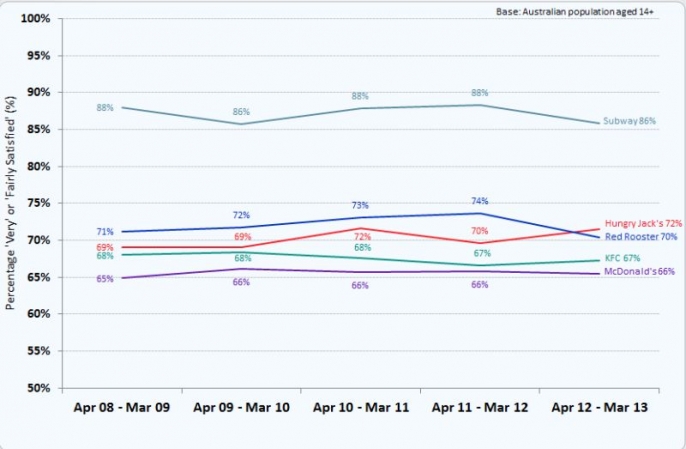
Challenger brands create new terms to compete on
Subway shows the rewards of zigging when the competition zags. While fast food leaders spent their product and promotion strategies on short term price promotion or new themes, from changing with the seasons, think summer pineapple burgers to following fashions, think cajun sauce. Meanwhile Subway went where no fast food had ever successfully gone before: the good for you. positioning.
The chart shows the relative strength of Burger King's "do less of the same, better" approach, and Subway's "do something completely different" model. Both are positively recognised by the consumer and continue to command a price premium to the slower to innovate fast food competition.
What size is a typical marketing budget?

How much is the right amount to invest in marketing?
Depends who you ask. The CMO Council asked hundreds of chief marketing officers around the world across categories how big their budgets are. While this was post GFC, it gives us a useful benchmark when planning ahead.
The starting point for setting a budget uses a top down approach based on your revenue. The chart we've made below shows the percentage of revenue invested in marketing by business to business firms.
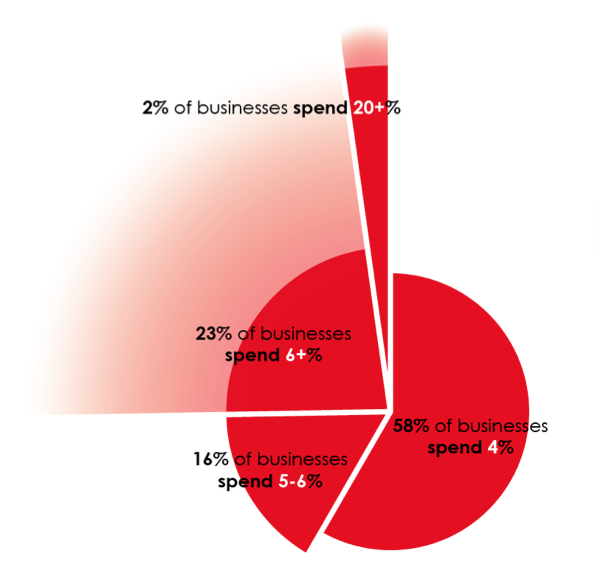
Percentage of revenue invested in B2B marketing
2010 CMO Council Survey
Interestingly, the consensus view amongst those surveyed was that a new brand launch required a minimum investment of 20% of revenue. As we can see from the chart, either there aren't many new brands launched in any year, or the majority aren't spending enough to ensure they don't fail.
Another way of determining the right size of budget is to compare how much is spent according to the size of the business.
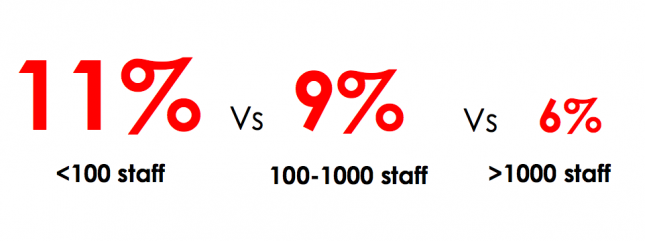
Percentage of revenue invested in marketing by company size
2010 CMO Council Survey
We shouldn't be surprised that as businesses establish themselves and grow, the number of staff grows. As they grow, the relative proportion of their revenue invested in marketing decreases. Marketers understand the long term nature of judging the return on investiment in marketing. Marketing that is consistant delivers compounding returns, a relatively large initial spend will pay dividends in the long term.
Average marketing budget for FMCG brands
A Go-to-Market survey in 2012 found this spread of investment by revenue of FMCG brands:
% of revenue % of companies
No budget 1.1%
0 - 2% 28.6%
3 - 5% 33%
6 - 10% 21.1%
11 - 15% 8.6%
16 - 20% 4.3%
20%+ 3.2%
You can use these percentages as a starting point for framing your marketing budget and then compare to the result of viewing your requirements from a bottom up view.

Bottom up marketing budget approach
Create a list of activities you plan to undertake across your integrated marcomms plan and estimate the required investments for each. Balance and adjust for frequency, reach and coverage. Consider set-up costs for all mediums and a realistic figure for content creation and creative, remembering the better the idea the less times your audience needs to see it to get a result. Factor in research and tracking and an allowance to have the flexibility to react and respond. Remember to allocate around half your total budget for labour, across both internal and outsourced agencies for development and management throughout the year.
Depending on the particular segment your brand is in, the consensus is a B2B marcomms budget needs to be between 3 and 6% of revenue and for FMCG between 6 and 12% to have at least a competitive share of voice.
Read MoreThe most and least trusted professions
Every year Roy Morgan releases a ranking of the trust Australians have for each of the professions. Advertising is down and real estate salesmen up in 2013.
Here are the jobs as they rank for trust in Australia
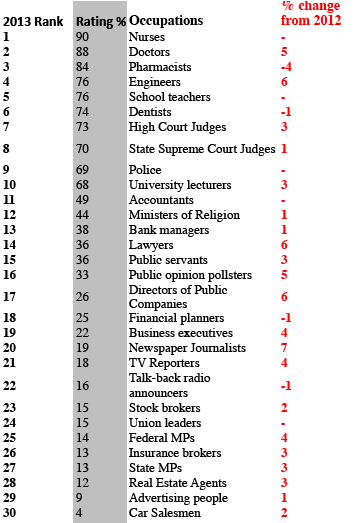
How does this compare on a global basis? See the global trust index.
Read MoreThe Naked truth on Rudd's interview for ads scandal

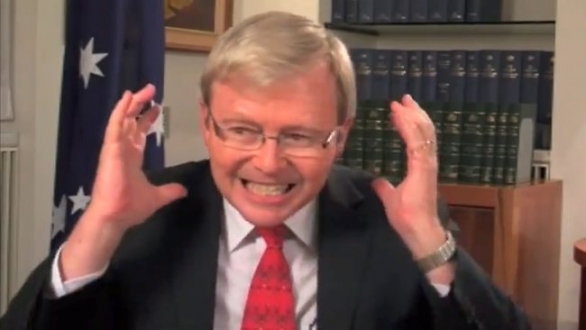
You probably already have an inkling the public rate marketers and ad people at the bottom of the trust scale for professions. You're right, they are down there with politicians. Something happened this week to reinforce the view that neither can be trusted, it's a classic example of an "whatever it takes who cares about the ethics" attitude.
Controversy blew up when Sydney based Naked Communications was exposed while working on a project for Labor when it offered video interviews with PM Kevin Rudd to online youth publishers in return for free online ad space.
Further blurring the lines between “an interview”, and an ad campaign, the agency wrote to Faifax owned The Vine they were “particularly keen for a deeper relationship (including putting investment behind your content on YouTube).”
They also encouraged the online publication to provide “access to pro-Labor or pro-NBN talent.”
When found with their pants down, Naked were fired by Labor. The Sydney Morning Herald’s political reporter, Jonathan Swan, who broke the story, said “it seemed very odd” that Labor was oblivious to the deals offered to online youth sites.
The agency’s CEO claimed no knowledge of the deal, blaming a younger staff member. Indeed, the day after it blew up the agency planner responsible was “no longer in the building”, having left for a holiday in the UK.
What has been adland's reponse to this question of maintaining standards?
Next day the Creative Director of Wonder wrote in AdNews “how much responsibility are we giving young and inexperienced executives? I think too much. Our industry is more impressed by 20-something backward baseball cap-wearing gamers that impress us with their social media savvy than wise old owls. Where are our wise old owls? Nobody could ever accuse the marketing industry as one that eats their young. Quite the opposite, we assassinate the old and we call anyone over 50 old. Mike Wilson (CEO) is Naked’s wise old owl and the bloke is only in his 40s.”
He then suggested the team at Naked vote Abbott to avoid a Labor backlash. This received some wise comments, my favourite from No Wonder of Paddington:
"Wisdom is not the province of age, and this is not an 'odd judgement error'. It's a failure from top down to create a culture of ethics... that at all times forces doing the right thing to trump making a splash for your client. Wilson may be the straight shooter he's characterised here to be, but as the leader of the pack, he's ultimately responsible for the culture that would spawn the actions of that 'rogue executive' who was shown the door"
"This isn't the first time that Naked has been guilty of pushing the envelope at the expense of common sense, and more importantly common decency. What's worse is that the creative drive to market at any expense has had a poisonous influence on the business in general, and in some corners legitimised the art of the stunt and the bad habit of erasing the moral line to such an extent that many of the young guns don't even know it exists."
"It's the agency that should take the fall in the end, not just the employee directly responsible, and encouraging them to vote for Abbott in an attempt to avoid the negative reaction from everyone that they richly deserve shows us all just how jaded the industry at large has become. Sad and sadder."
SMH's Swan labeled the agency “a bit wild west, they’ve got a cowboy reputation” and said they have a history of “doing things a bit off-piste”. Swan also mentioned the infamous fake Facebook Witchery coat campaign which duped both mainstream media and social media users in 2009.
When does online content become advertising?
According to the ACCC and AANA it’s one and the same in the eyes of the law, as we can see from the new Code on marketing communications that encompases social media.
Gabriel McDowell, MD of PR firm Res Publica pointed out the new risks inherent in attempting to leverage digital channels: “From a crisis management perspective, and based on the reported facts so far, I think the ALP has reacted promptly and appropriately to try to limit reputational damage to the Labor brand. They have made it clear they didn’t sanction the offending proposal and firing the responsible agency was a justifiable response given the seriousness of its misjudgement.
"And there can be no doubt that it is a whopper of a misjudgement because building trust and understanding between a brand and its public is the fundamental objective of any communication campaign and deliberately blurring the lines between editorial and advertising can only erode trust when it is uncovered.”
"It has never happened before. My mouth was on the ground. Young people are politically engaged and this is not the way to go about appealing to them. It is why we tend to shy away from the major parties."
She told AdNews it was "exactly the sort of thing that is killing media", but that brands generally grasped the value of editorial over paid content.
The challenge for the communications industry is while we may have self-regulation, only a handful of agencies are Accredited by the Communications Council. UNO is, Naked isn't and most clients don't appreciate the difference. As I commented to AdNews, "what's the point of having an agency Accreditation scheme when people arrive at work having forgotten to pack the moral compass. If we want to be regarded higher than real estate salesmen, which the latest research shows we don't, both clients and agencies need to keep briefs away from the irresponsible."
Will digital spell the end of editorial integrity?
This has all happened less than a week after Adnews editor-in-chief Paul McIntyre expressed a fear for the future of publishing as the title becomes a defacto re-publisher of PR releases and sponsored events. This is what he said in an open editorial:
"Change can be painful but equally stimulating. Just as long the industry knows where it’s all headed and in what direction it is pushing its industry media. It won’t be too far away, for example, when you all can hack back your budget for PR operatives. And PR types, brace for a much harder slog. Seriously, most of you won’t be needed. The deluge of PR-generated ideas and story angles is rising rapidly while the ability for business-to-business media to cover it is declining at the same pace. Don’t forget that. Okay, sorry, rant over."
Read More
The Lynx effect: Marketers need to help business managers focus on the long term.
Yes, the world is experiencing rapid change and it’s accelerating. However with the average tenure of management in companies constantly getting shorter, retained knowledge is being lost and long term plans are often abandoned before they have a chance to deliver returns. Short termism is rife, sales managers will always tend towards a quick fix to get orders in this month, and financial controllers will naturally be looking for new ways to reduce spending.
Yet the bottom line is it's the businesses that invest year after year in building brands that create the most wealth. The chart below compares the S&P 500 index performance, the blue line, with businesses that own stronger brands, the green line. It proves the businesses that invest in brand building ultimately generate more wealth for shareholders.
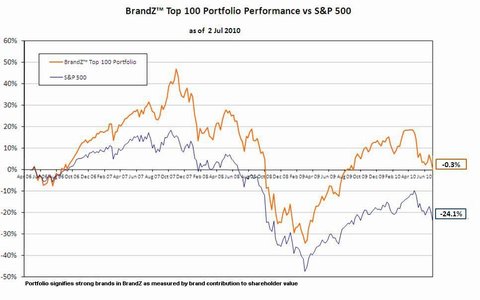
Leading brands outperform the sharemarket
A great example of how building a brand over time makes more money is to look at the work BBH in London did for Unilever. The creative leap of saying a deodorant could make a man more attractive changed the dynamics of the market category. The ad agency took an also ran product to a profit powerhouse over 20 years with the one consistent creative idea; “The Lynx effect”.
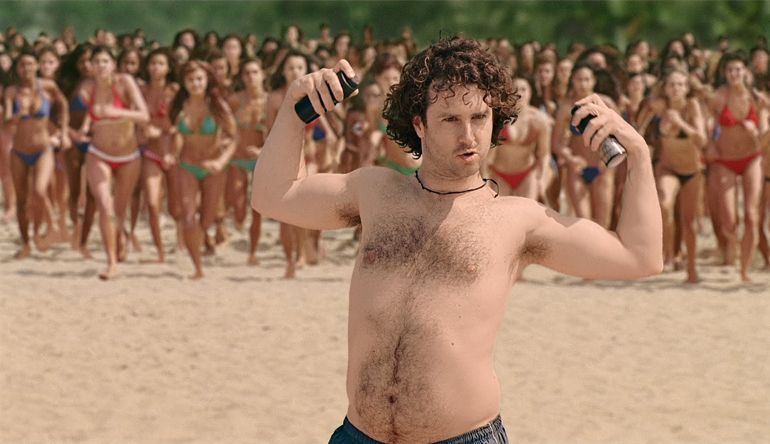
Founder of BBH Sir John Heggarty says “All we did [back in 1995] was change the thinking. It’s more than a fragrance – anyone can make a fragrance – it’s actually about the marketing.”
"I fundamentally disagree that advertising is just selling people stuff they don’t want. I believe that you have to create a competitive advantage with creativity. It seems obvious but I spend so much of my time trying to convince marketers to be more creative.”
Marketing is more art than science says the global advertising guru
Last week in Sydney Heggarty told a room full of businesspeople and advertisers “you all want it to be a science, to get the equation right and go home. But selling stuff has never been a science, it’s about persuasion and it’s an art. It will never be a science. It’s important to remember that we’re all creative. If you’re in marketing, you’re creative.”
Branding today is worth more to a business than ever before
Here is the proof for the finance department. According to Millward Brown Optimor’s analysis, in 1980 virtually the entire value of an average S&P 500 company was comprised of tangible assets (computers, factories, inventory, etc). By 2010, tangible assets accounted for only 30 to 40 percent of a company’s value. The rest is intangible value, and about half of that intangible portion, close to 30 percent of total business value, is attributed to brands. Does your CFO treat your own brand as your single biggest asset?
It truly is the era of creative destruction. ROI marketing is one of the few tools left that can still make a difference and consistently drive business growth. It's worth investing in your brand if you want long term returns.
Read MoreHow many ads do we see a day? Do you remember any?

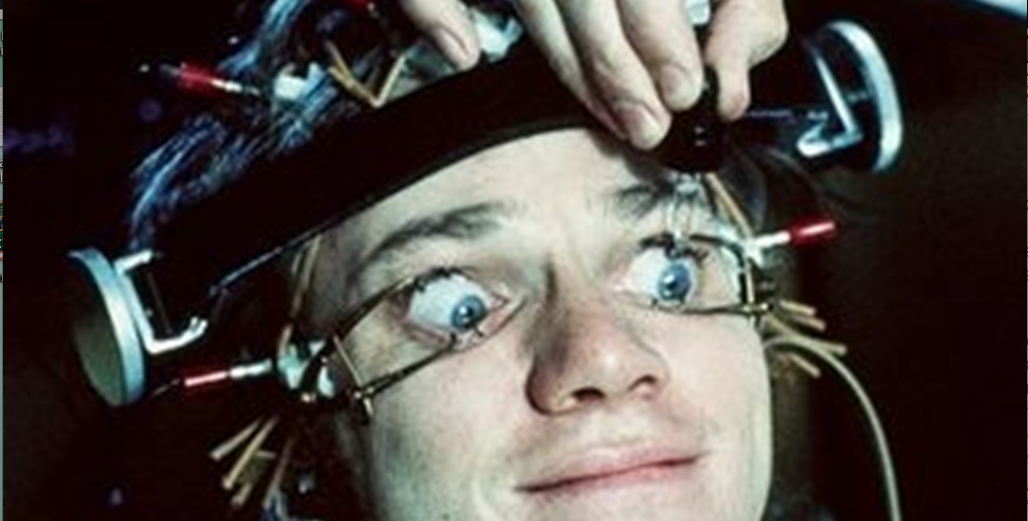
"We've gone from being exposed to about 500 ads a day back in the 1970s to as many as 5,000 a day today."
Jay Walker-Smith, Yankelovich Consumer Research
Hard to believe? Well, if you include the brand label on your undies when you put them on in the morning to the box your new tube of toothpaste came in that evening you can conceive you are exposed to branding messages thousands of times a day. This researcher also counted all the junk mail you probably don't read. But 5,000 ads?
A more reasonable figure for the marketing messages you see and hear daily is probably in the hundreds. Think about your average day, from the traffic report brought to you by Bob Jane T-Mart, the bus back for some show at The Star to the flyer for a Thai massage thrust in your hands as you walk past the poster for all-you-can-eat ribs on Wednesday nights. Then a barrage of down down retail ads on the TV during My Kitchen Rules, sponsored by some diet program. And those meet women in your area now!! ads on the side of your Facebook page late in the evening? What’s that about?
Whether it’s 300 or 3,000, we see so much that we register very little – and remember even less.
So if you were advertising your business don’t you think it might be wise to be distinctive and consistent enough to be recognised for something? Of course you would. So why is it most marketing communications is neither memorable nor consistent? Why doesn’t Qantas still call Australia home?
Why would an insurance company kill off its leading actors?
I can understand why an insurance company is killing off a 3 year ad campaign featuring Rhonda who now has a full time gig in a soap, but why did they drop the memorable jingle earlier? What have they got left to ensure we remember their brand? Who was that insurance company you may well ask? Ahhhhh, Allianz? No, when I double checked it was AAMI. You'd be forgiven if you haven’t been paying attention. Instead of keeping the sign off, "Luckyyyy, your with AAMIeeee", the ads no longer end with the sound of the jingle we’ve grown familiar with over 15+ years. Wonder why?
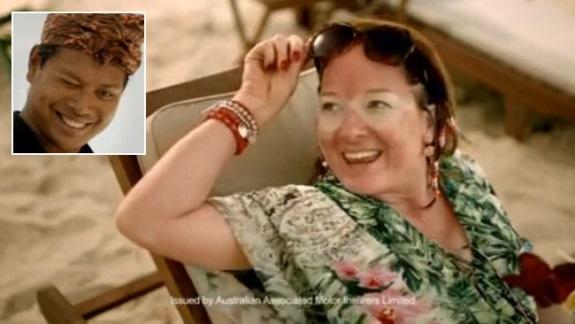
The average tenure of the CEO of an ASX 200 company is around 4-5 years*. The head marketer changes almost as often. Those brand managers on their way up move through more often, leaving behind their mark like my pug does on street posts. Which explains why the labels on all those Lindemans wines changed so often over the last decade. Southcorp then Treasury have destroyed so much brand equity because there were no custodians with a strong thread of brand DNA. Then each new agency wants to make its name, often at the expense of the advertiser.
Why will anyone remember your brand?
I was part of the team that created the "Which bank?" campaign for Commonwealth. It outlasted my time at Saatchi and survived a change of agency, despite their attempts to get rid of it. Brand building is like compound interest, you add a bit every year. And after a while it’s worth a fortune.
'Oh what a feeling' to be a copywriter for Toyota, knowing whatever the concept you come up with, the last 25 years of ads ensure the jump at the end will guarantee recognition by a half asleep viewer. Which is why the most successful marketing campaigns are the ones with legs. They go on and on like a Duracell battery.
It’s a fine balance between testing the new and stretching the offer without breaking the elastic brand. Some brands get it right. While there have been numerous small tweaks and occasional lapses, the VB can and the Coke dynamic-ribbon have survived decades of personnel changes. Less strongly managed brands seem to change annually. So when clients tell me they are getting tired of their campaign or their tag line or the font of their logo, I like to check if it’s busted first.
Sure we live in a world of rapid change, however, it’s more likely business survival and growth will come from product and service innovation and smarter marketing techniques, not from a new typeface. It may be a better strategy to refresh and re-launch rather than completely start again if you want to hold on to some rare customer goodwill. You’re doing well if they already have a small place for your brand pegged out in their cluttered head space.
Mortein tried to kill off Louie the Fly, but after over 50 years the public would have none of it. As John Laws used to say, when you’re on a good thing, stick to it.
Here's a Louie the fly ad from 1962
* Source: A Booz & Company study shows 23.5% of CEOs of ASX 200 companies left in 2011. Median tenure is 4.4 years and falling.
Read MoreThe top 20 valued brands in 2014
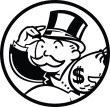
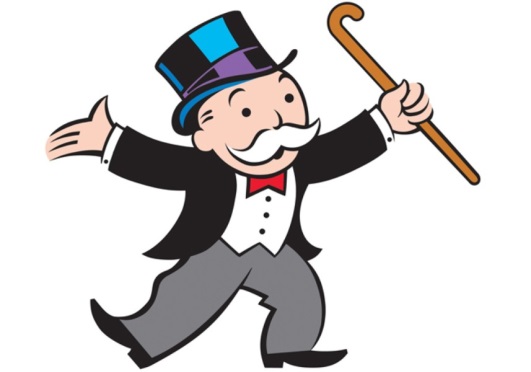
The world's most valued brands include some surprises. Coke is no longer it, in fact in the last year the brand value of Coca Cola has actually shrunk by 1%. Might not sound like much, but we are talking US$50million. A few more great ads like they used to make could have made a big difference to the bottom line. While there's a lot to lose there is a lot to be made by building a brand.
Innovation and marketing build brand value
Consider the year on year growth of Samsung as it continues to invest in product innovation and marketing. Now the number 2 in the world by brand valuation, Samsung increased it's value by US$20 billion over the last year. Coke slipped from number 9 to 12. Check out US telco Verizon, up from 10 to 5. Expect to hear more from them in Australia.
What are the highest valued Australian brands?
The value of a brand can be greater than the parts and isn't necessarily a reflection of the relative size of the business. While Australia's largest listed company by share market value is BHP, it doesn't rate on the scale for the book value of it's brand. The business with the highest valued brand in Australia is Woolworths. Woolworths sold $21 billion of food and liquor last year. The Woolworths brand is now ranked just outside the top 100 global brands and is valued at US$10.8 billion.
Racing up behind in second place is a newly invigorated Telstra which has re-invested, refreshed and relaunched it's brand over the past couple of years. The several millions spent on marketing has been rewarded, Telstra jumping 34 spots globally with an increase in brand value of over US$2.2 billion.
The banks brand valuations aren't the same as their market cap, but the shifts in brand value are a leading indicator of performance. ANZ is the smaller of the big 4 banks yet it has had a higher brand valuation for the last few years. But it's slipping, which helps give us an idea of which bank will grow faster in the coming years. ANZ, NAB and CommBank are all losing brand value and Westpac is climbing as they leverage stronger brand appeal to hold and grow customers.
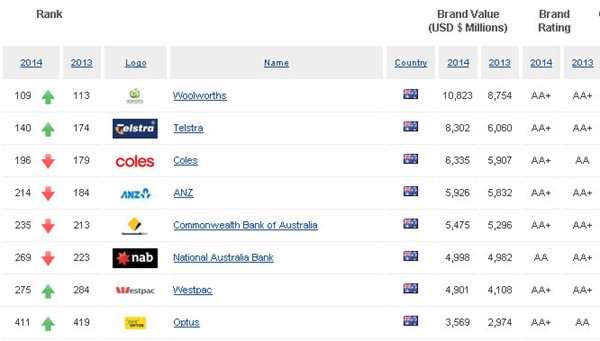
So when you're in the boardroom discussing the pros and cons of discounting to drive sales or investing in marketing, show your peers what a difference a brand makes to the bottom line.
Read MoreThe business benefits of a strong brand
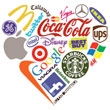
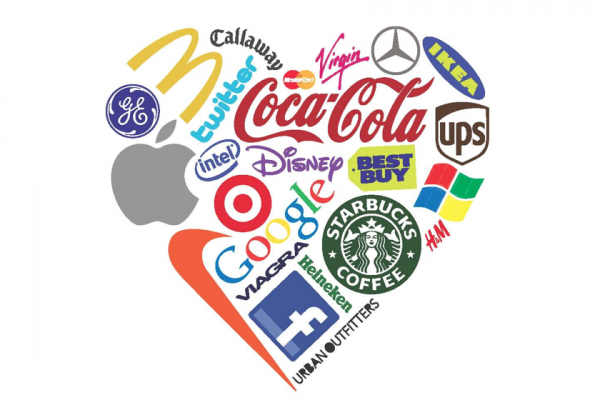
Remember just over a decade ago when IBM only sold big computers? Today most of us have more computing power on our smartphone and IBM is a consulting services business. UNO helped IBM make the transition to a service provider to mid-sized Australian businesses with a 4 year content publishing programme.
Many brands are having to change to survive
A few years ago if you wanted to find a business service you looked up the Yellow Pages. And if you wanted to make a call when you were out of the office you had to find a pay phone. It's amazing when you stop and think about how much the Internet has changed the way we do business.
Some once mighty brands like Kodak and Darrel Lea have disappeared, while others have successfully transformed what they offer. Have you taken the time to reconsider what your brand stands for in today's competitive market?
A brand is more than a name and logo
Your brand is what the public thinks you stand for. How you present your business shapes how your brand is perceived. Your brand is how your customers feel about you – the impression you make. It's how you look and how the way you speak. It's the unique way you reveal yourself to customers, from your choice of words to the typeface and colours you use.
If your business has been around for a decade then what your business does may no longer be well represented by what your brand is representing. Today's brands are distinctive yet flexible. Consider wWhat do Apple, Google and Virgin have in common? An ability to sell products and services across virtually any category by leveraging strong brand images that represent values that can be stretched as innovations are brought to market.
Strong branding is a smart business investment
Disciplined brand creation and consistant brand marketing is proven to deliver returns. Once you've differentiated your brand positioning, today you need to remember sales is no longer a linear pipeline, the power now lies with the customer. So for your brand to create wealth it needs to be discoverable across multiple touchpoints. With consistancy, the ROI from building a differentiated brand isn't just financial.
A strong differentiated brand enables the business to:
• Overcome competition based purely on price
• Prevent or slow decline of sales
• Hold on to existing customers
• Build sales leads
• Change perceived quality of your product
• Revitalise customer appeal
• Change company culture and boost employee morale
• Enter new markets
• Speed up product acceptance and trial
• Morally discourage competitors’ salespeople
• Raise capital more easily
• Sell a business more easily
See UNO's proven Formula for Growing Challenger Brands.
Read MoreWho owns the world's best known brands?
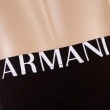
"Brands are intangible assets and account for, on average, 75% of the value of a company."
– Blake Deutsch
Investors don't value what businesses make. The sharemarkets around the world have placed the most value not on production, rather they value the power of brands. Most share prices are a reflection of the future earning ability of a brand. The brands people most recognise also get the most votes from investors.
Just ten global companies own a surprising number of the world's best known brands.
From cat food to confectionary, shampoo to fragrances, each of these companies use their marketing skills to create shareholder value. As well as the dairy brands you probably associate with Nestle, the Swiss company also owns some of the most renowned brands in other diverse categories. Most people are surprised to see just how many categories just ten global corporations are active in. (View on Pinterest):
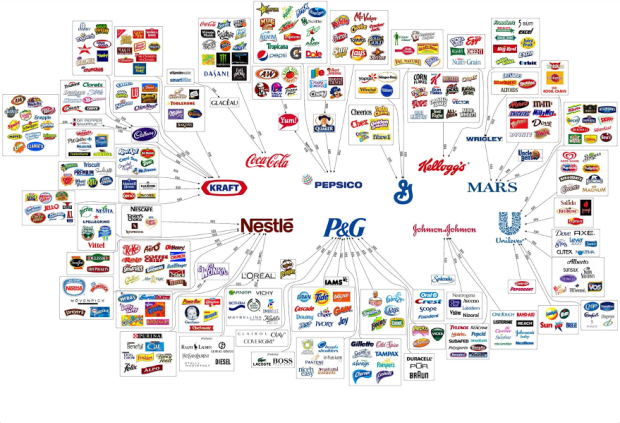
See larger image on Pinterest.
The big benefit of differentiating your brand is pricing power
The same marketing disciplines that are used to by Nestle to differentiate Kit Kat are leveraged by Nestle in other categories like fragrance. Georgio Armani Beauty is a Nestle brand, with Cate Blanchett its public face. Differentiation is why Nestle can charge a premium for perfume, Purina pet food and Nespresso coffee capsules.
In an Internet enabled world, where prospects can literally buy anything from anyone, it is now essential to differentiate your brand. It is differentiation that will ensure long term sustainable and profitable business.
Big brands have the world covered, which opens market niches to the nimble
The good news for challenger brands is the majors have slimmed down their portfolios over the last decade to concentrate on a smaller number of brands they can manage globally. So if you now apply the same proven brand marketing disciplines in niche markets you can most likely do so knowing there will be less competition from big global players.
As for Armani the fashion brand, it's still a family owned business with Georgio, it's 78 year old founder, still at the head. See how UNO grows Challenger Brands, including a number of successful Australian family businesses, just download our free eBook.
“Brands are intangible assets and account for, on average, 75% of the value of a company.” - Blake Deutsch - See more at: http://www.r-co.com.au/brand-building-for-business-success/#sthash.XGEEw6MT.dpuf
Who tweets about brands?
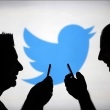
Technology companies get the most tweets
If Twitter users are image shapers, setting the trends in awareness in our society, it follows that marketers want to see their brands tweeted. Research by Nielsen has for the first time shown which brand categories are most tweeted, and who is doing the tweeting. Technology companies lead, followed by restaurants.
How to get people tweeting about your brand?
Be seen on TV. The age old adage, fame is the name of the brand game is underlined by the fact the brands people tweet about are the brands seen on what is still the world's mass market medium – TV. Perhaps this explains why the biggest brands still invest in TV advertising, it's the one medium that they can still use to shape mass opinion.
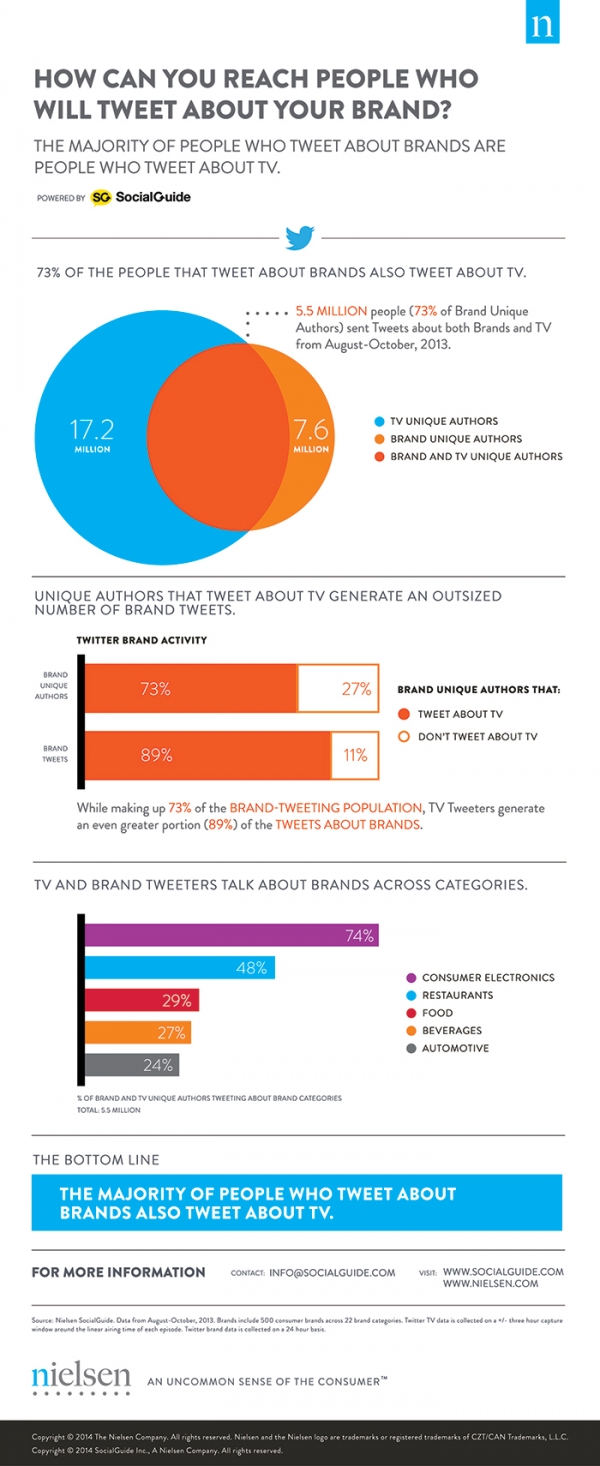
What Australians look for when shopping online

Myer missed the post-Christmas online retail rush, and it was BIG. On 1 January, The Australian Retailers Association put an update out on expected post-Christmas sales from Boxing Day to 14 January to be $15.1 billion.
You may have read Myer's site was down for over a week. CEO Bernie Brookes told shareholders it wasn't a big deal because online represents just 1% of Myers sales. I'd be wary of investing in a retail business that doesn't realise the importance of e-commerce.
6.4% or retail shopping is done online
In the year to November 2013, Australians spent $14.6 billion* on online retail. This level is equivalent to 6.4% of spending with traditional bricks & mortar retailers. Some discretionary spending categories are already well into the double digits for online sales. Despite Bernie's spin about the insignificance of his own online sales, in fact Myer's business plan has a 5 year target for online sales of 10%.
I've been brushing up on online retail best-practice
Those retailers that did get a share of the online post-Christmas sales rush now have stats on what worked for them. Fortunately we can all learn from what Australians did over Christmas thanks to a survey by Credit Card Selector of online gift purchases. Here are some of the insights on what shoppers are seeking online...
Why Australians purchased Christmas gifts online rather than instore
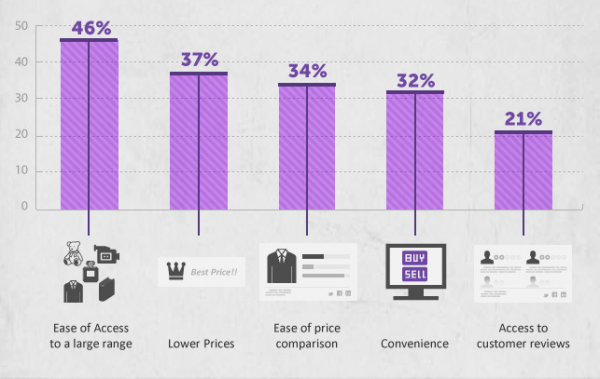
How shoppers find online stores
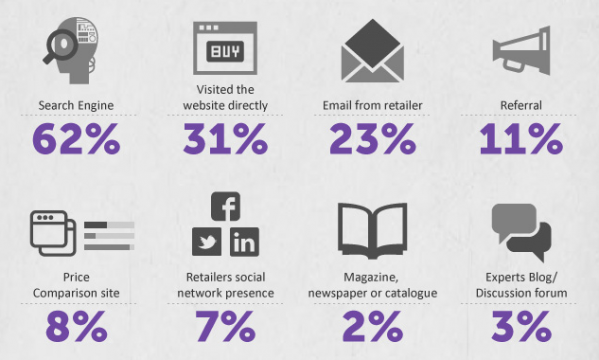
What gifts shoppers bought online in 2013
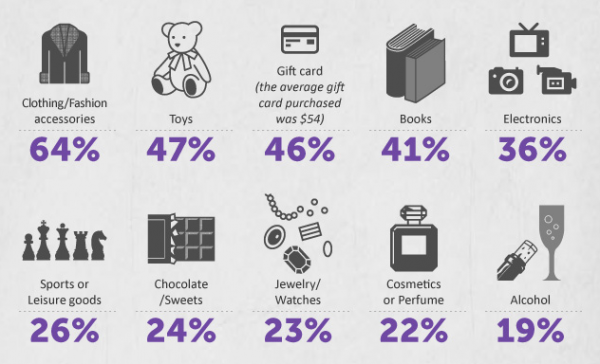
What would make an online shopper buy again
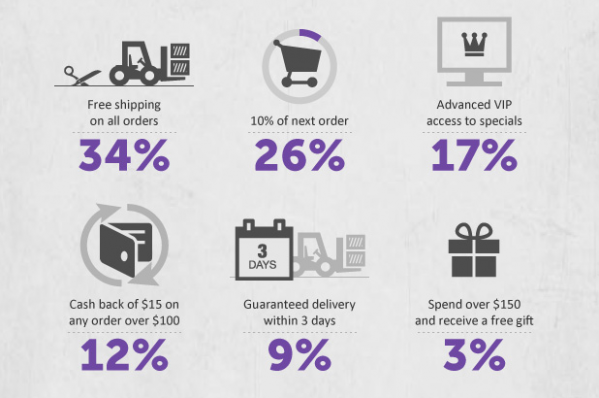
* Source: NAB Retail Index
Read MoreHow can you measure a marketer's contribution to the business?

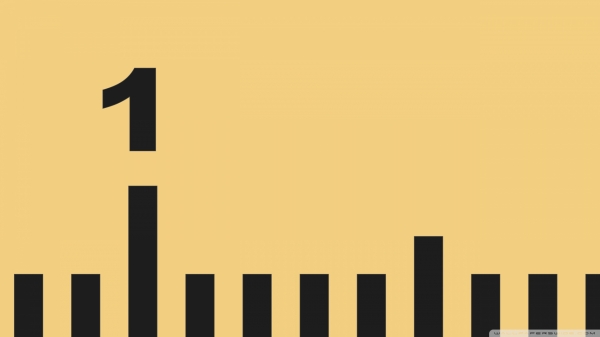
CEOs and business owners often ask me what’s the best way for them to measure my contribution to their business. The business of business has never been more complex, yet we are actually in an era where marketing is one of the few levers left that management can actually control to engage customers. And that’s how a marketer is best judged – by the improvement of the brand’s engagement with customers.
Marketing is all about the customer. The customer
Don’t just take my word for it.
A survey of CMOs across 92 countries reveals consensus – the most valuable measures of marketing’s contribution are in the areas of engagement and “brand health”. Health being a bit of a catchall word for the grab bag of KPIs that show how much customers recognise you, like you, value and understand what you stand for. They also ranked the capabilities that will be more important to marketers over the next 5 years.
KPIs for measuring marketing effectiveness
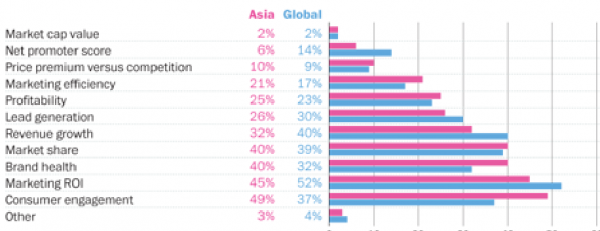
Source: The Marketing 2020 Report, Effective Brands survey of 10,000 professionals across 92 countrie
The capabilities most important for marketers in 5 years
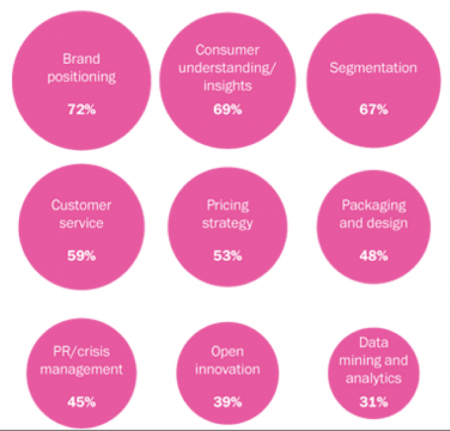
How to manage the 9 biggest marketing challenges
Here is how we manage the biggest marketing challenges today:
- What do you stand for?
Define your differentiated positioning in the market that not only you have a passion for, enough prospects will pay for. - Know your customer
Base your story on what customers genuinely care about that you can deliver. The features with benefits that ideally are unmet by competitors, or unknown to prospects. Think like a challenger brand. - Define your target audiences
Don’t attempt to sell something to everyone. It’s the era of niches within subgroups. Align your messages to what each customer target cares about. - Customer service
Never over promise, always over deliver on expectations.See some of the proven ways to foster customer loyalty here. - Pricing strategy
Remember pricing is a two way lever, framing value to maximise profit is the game, not cost plus pricing, that was the era of mass market production line manufacturing. Be nimble and exploit unique profit opportunities from short term market mispricing. Then find another. - Packaging and design
Sell the sizzle. Creativity and a consistent brand image increases cut through, recall and engagement and helps you command a price premium. Bad ads are bad for business. Stand out and apart. Safe isn’t just boring, it’s high risk. - Be prepared for a crisis
The Internet now makes everything public and places the power in the customer’s hands. Have a plan. Tell the truth, you’ll be outed if you don’t. Make sure you know your legal position with social media. - Innovate for growth
Or die. Big business struggles to change, this is the great advantage for those who aren’t market leaders. Become a challenger brand by zigging while the category zags. See the bottom line benefits of innovation as determined by AIM, they are significant. - Data
We are now in a digitised world. The companies that have the most data on people have the power to own their custom. Whether you are a manufacturer, distributer, service business or retailer, the business that makes the most of data will control the money.
Read More
Email outperforms social media for new business, by far


McKinsey has just published some research I wrote about last year on the ineffectiveness of social media for customer acquisition. While marketers have increasingly jumped on the social media bandwagon, the stats show the effectiveness of Facebook and Twitter as a method of acquiring customers has remained flat. In contrast, email’s share of customer acquisitions has shot up over the last three years by 700%.
% of customers acquired by channel
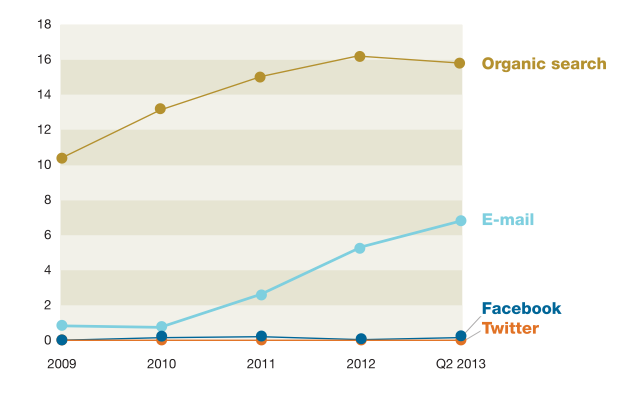
Source: Custora, E-Commerce Customer Acquisition Snapshot, 2013. McKinsey iConsumer survey
The tip for challenger brands here is to zig when the others zag. The more your competition and every other marketer swamp social media with activity, the less likely you will be noticed. Personally, every time I now venture onto Facebook I am actually getting rather tired of being targeted by advertisers for diets, wine and dating.
Facebook is out of favour for new business
In the quest to deliver Facebook shareholders a profit, marketers are being encouraged to spend big. Meanwhile Facebook users are beginning to move on. The statistics show us those marketers who continue using email can expect 40 times the customer acquisition than from Facebook and Twitter combined.
That's not to say I'm recommending mass email blasts. The frequency of spam in your inbox is why marketers now have to be more discerning in what they send and who they send it to. For instance, Qantas has a frequent flyer database of 10 million members, slicing and dicing and and segmenting offers with hundreds of individual creative executions.
When Email marketing, remember what’s in it for the customer
Most of us hate spam. Prospects and customers however generally appreciate receiving an email when it concerns something of value to them. Depending on your category, different days of the week achieve higher responses. And of course, research on brand recall has proven the more creative your message, the more your brand will be remembered.
So make sure your email campaigns are well crafted and you offer a real benefit aligned to a genuine customer need. In other words, smart marketing not spam.
Read MoreHow Private Label hollows out brands

Australia is unique for the oligopolistic power of just two supermarkets. Coles and Woolworths have 80% market share of an industry valued at A$80+ billion.
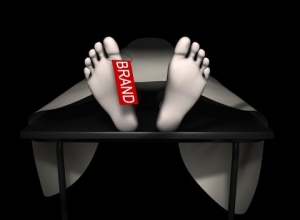 In the UK, the two major chains Tesco and Sainsbury have 48% and the US equivalent is just 20%. Consequently when our retailers brought in management from the UK to apply the successful Private Label model developed by Tesco and Asda they did so with the potential to have a significantly bigger impact on our market overall.
In the UK, the two major chains Tesco and Sainsbury have 48% and the US equivalent is just 20%. Consequently when our retailers brought in management from the UK to apply the successful Private Label model developed by Tesco and Asda they did so with the potential to have a significantly bigger impact on our market overall.
Private label is no longer cheap generic Black & Gold commodity lines, it's the key to the retailers growing profit at the expense of both brands and producers. Whether you are in the FMCG business or a service business, the Private Label strategy is one that threatens every business as the company with the most customer data gains ownership of the sales process.
Global FMCG brands now struggle to turn a profit in Australia
In the last year major FMCG brand owners like Unilever and Nestle have publicly lamented their lack of power in this country to compete with the oligopoly's own brand agenda. While we have more supermarkets per capita than the US and nearly 3 times as many as the UK, the 10,000 Australian independents have so little share and such disparate distribution requirements for fulfilment they offer brands little scope for profitable scale.
Most shoppers don't realise they're being had
The trend to consumer demand for more brand choice and gourmet choices is being matched by Woolworths by it's purchase of Macro Wholefoods and roll out of Thomas Dux stores. Not only have Woolies out-merchandised the Harris Farm model, they've done an even better job in wine.
Together, Coles and Woolworths have over 50% of the liquor market, not just through retail store brands like Dan Murphys, Liquorland, 1st Choice, Porters, Theos and Vintage Cellars, but the big online database driven direct marketers like Cellarmasters and Langtons. Here is how Choice sees it:
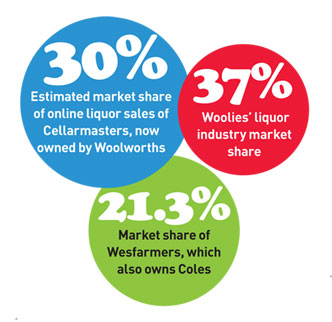
This dominance has enabled the two majors to dictate what brands you can buy. They have delisted most small vineyards and substituted them with a cynical excercise in facadism. There is a plethora of over 240 Private Labels masquerading as boutique wines giving the impression of choice. They are merely made-up attractive wine labels stuck on bottles of mass produced vin ordinaire. From Abbey View to Willowbrook, see the list of fake wine brands for yourself.
Now they are using their data Intelligence to segment and market everything from Private Label credit cards to health insurance. For instance, they use loyalty card tracking of grocery purchases and the knowledge that if you eat red meat you are a better actuarial risk to target the insurance sales process. What insurance company can compete with this big brother view of Australians?
How does a business compete with this onslaught? A study by international branding expert Professor Mark Ritson of Melbourne Business School gives some insight...
The formula for Private Label success
• Lack of perceived differentiation between brands in a category
• Lack of value innovation of incumbent brands
• Increased proportion of price promotion activity
• Available production capacity
• For me products
• Smart retailers
• Competitive retailers
• Concentrated retailers
The power of the retailers in this market allows them to demand more price promotion from brands, which leaves little in their budgets for brand building marketing campaigns or new product innovation. In no time the brand values are hollowed out, leaving the category ripe for Private Label substitution.
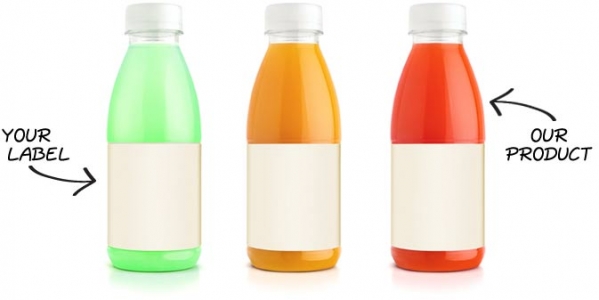
The Seven stages of Private Label dominance
Stage 1: Price-based generics (Home Brand, Black and Gold etc)
Stage 2: Copycat (Penguin vs Puffin biscuits)
Australia has passed here and well into the next stage.
Stage 3: Good, Better, Best (Tesco Value, Tesco, Tesco Finest)
Stage 4: Flanker brands (brand extensions to attract brand 'switchers')
Stage 5: Category leaders (Sainsbury Extra Special Tea Bags)
Stage 6: Non exclusive (expanding beyond the store)
Stage 7: Legal monopoly
The supply side to killing brands
The no-name supplier is offered a carrot to become the stick that wacks the known brands.This business is often an existing maker of their own known brand line. Why would a Heinz for instance supply Woolies Private Label baked beans? This is what attracts them:
- Usually opportunistic origins
- Often based on excess capacity utilisation
- Any contribution over variable costs of production is seen by management as good
- Less profit... but still profit
Where it leads is usually not so positive. Here is what happens when the no-name supplier exceeds production capacity:
- Increased production costs for same or less profit
- Cannibalisation of existing branded product
Gradual strategic 'split':
- From brand builder to PL supplier
- Internal resources get utilised
- An implicit strategic change
Change of business from:
- Brand builder / innovator / consumer focus to
- PL supplier / cost cutter / business customer focus
Private Label and the weaker brands are consolidated:
- As PL grows weaker manufacturer shares decline
- Brand fights brand – not PL
- To maintain brand and shelf presence, 'lesser' products become 'propped' up with disproportionate costs
- Resources become further diluted
- Finally, once mighty brands are de-listed by the duopoly
- The retailer approaches a new potential supplier for PL, and so it all repeats
How high can Private Label go? (How low will brands fall?)
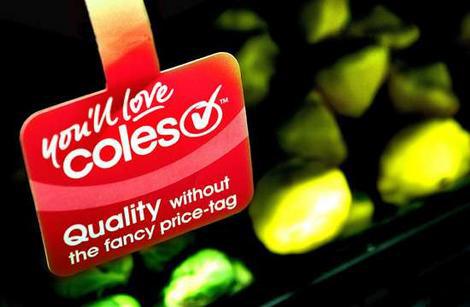
Private Label share in Australia today
23% is current floor
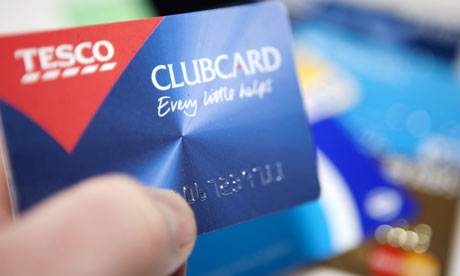
The UK is in the middle
50% Private Label
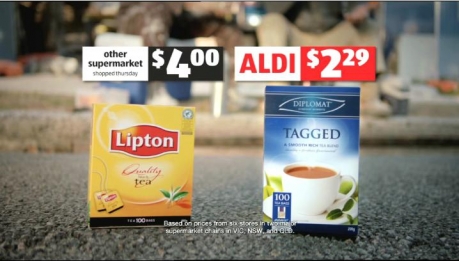
Theoretical ceiling
95% of product in Aldi is Private Label
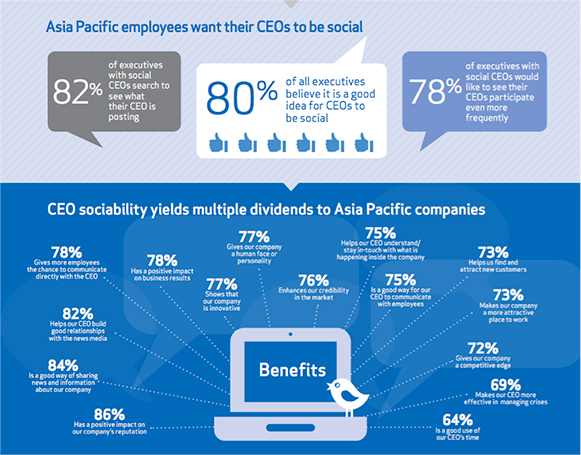
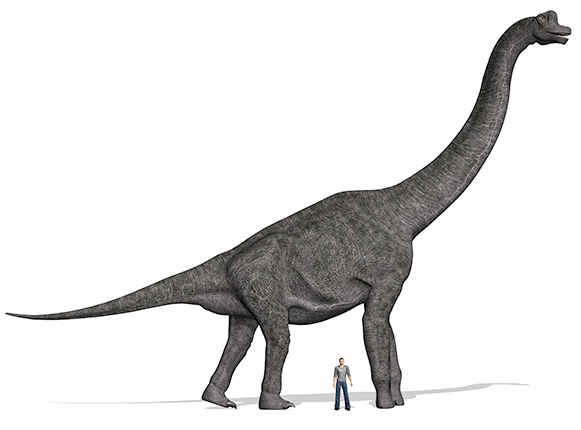
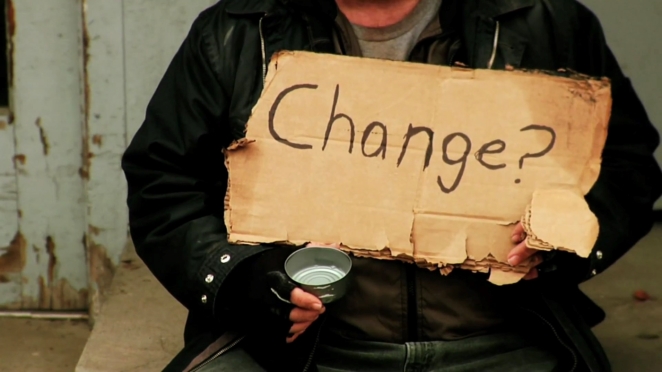
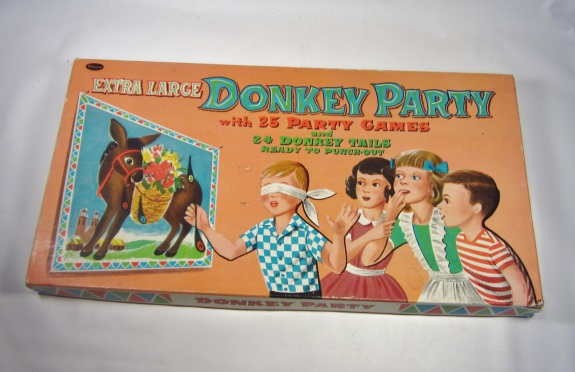

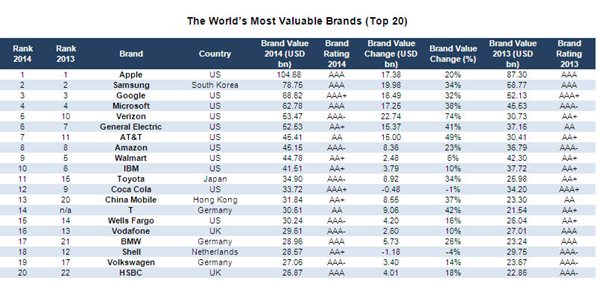
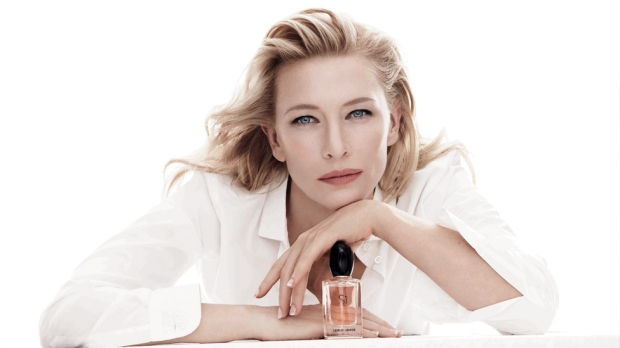



Scan the QR code for our contact details.
Download the Neoreader app.
© COPYRIGHT 2013 UNO marcomms Privacy